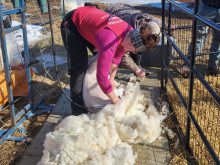REGINA – When the Latimer family tours the polled Hereford stalls at
Canadian Western Agribition, they see more than a third of the animals
carry Remitall breeding in their pedigrees.
“It’s nice to see other breeders using your cattle,” said Gary Latimer,
whose family name has been synonymous with the purebred Hereford
industry since 1960.
The family home-steaded in the Olds area in 1901 with Shorthorn cattle.
Louis Latimer, who is now 79, introduced polled Herefords in 1960 and
Read Also

Charges laid after cattle theft
Saskatchewan RCMP lay two charges against a man after six cattle went missing.
Black Angus in 1979.
His sons, Gary and Bryan, along with the grandchildren, run the place
where they manage 170 Angus and 180 Hereford cows.
The family is now into its fifth generation on the same farm where
everyone has a job to do, whether it is working with cattle, putting up
feed or merchandising livestock.
“We’re a real family farm. It’s actually a pretty small farm that
supports three families,” Gary said.
Last year they held three production sales and handled their own
management and publicity. Bryan is in charge of promotions, doing
animal photography, catalogue layout and advertising campaigns.
At their bull sale on the farm last spring, they offered 110 Hereford
and Angus bulls.
They have always emphasized the importance of highly productive cow
families.
“You have to have those great mothers,” he said.
Currently, they are riding high with a cow named Remitall Catalina 24H,
Canadian national champion in 2000. A half interest in this 1998 cow
sold at their production sale in October for $140,000 to a new partner,
La Grand Herefords in South Dakota. This established a Canadian
Hereford record.
Gary expects the cow will remain productive for another 10 years. It is
due to have a natural calf in January and then enter the flushing
program.
“We hope there is another Catalina,” he said.
It produced a bull named Online that has won both the Canadian and
American national Hereford shows. The bull is owned in partnership with
an American syndicate, and was bought for $92,000 at the Remitall 2001
production sale.
In the last decade, a bull named Remitall Keynote 20X set the pace for
the current breeding strategies. The bull died in 2001 when it was
nearly 14 years old.
It had served in the Remitall pasture for 11 years and sired a line of
herd bulls and cows for the Latimers and other herds.
While outcross bulls are introduced every year, the Latimers rely on
highly selective breeding that has been achieved with line breeding of
home bred bulls to replicate qualities like length of body, good
muscling and highly marbled carcasses.
In addition, breeding bulls have an ultrasound to test for carcass
quality through ribeye size, backfat and marbling.
“We’re trying to put as much meat on these cows as we can,” Latimer
said.
Although they have sold cattle to some of the elite herds in North
America, they maintain a strong list of repeat customers from the
commercial side.
They prefer to be known as practical cattle producers rather than
promoters.
They say quiet periods at the ranch are almost unknown. Life slows down
for a couple of weeks around Christmas. Then they gear up for a major
trip to the Western National Stock Show in Denver, Colorado, where
they’ve won a number of honours over the years.
Calving starts in January and the family mobilizes for another year.

















